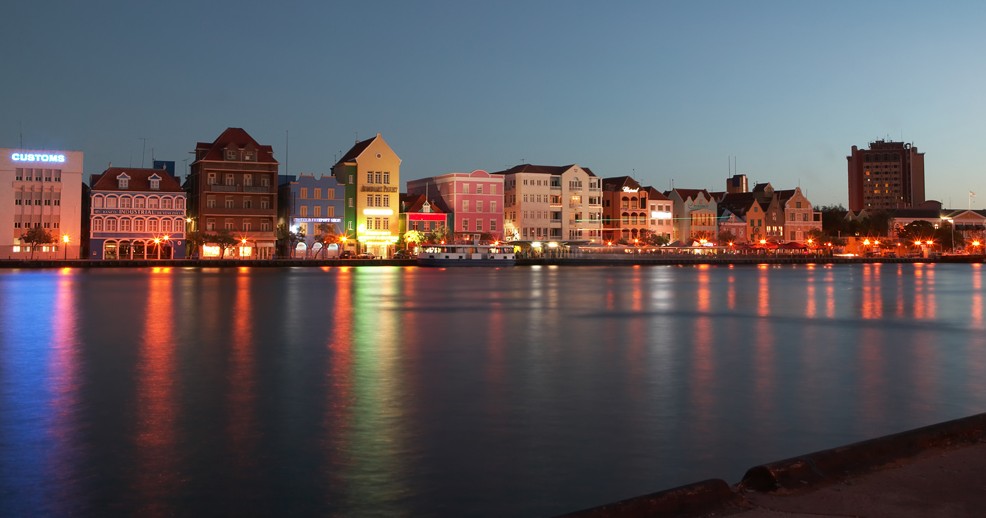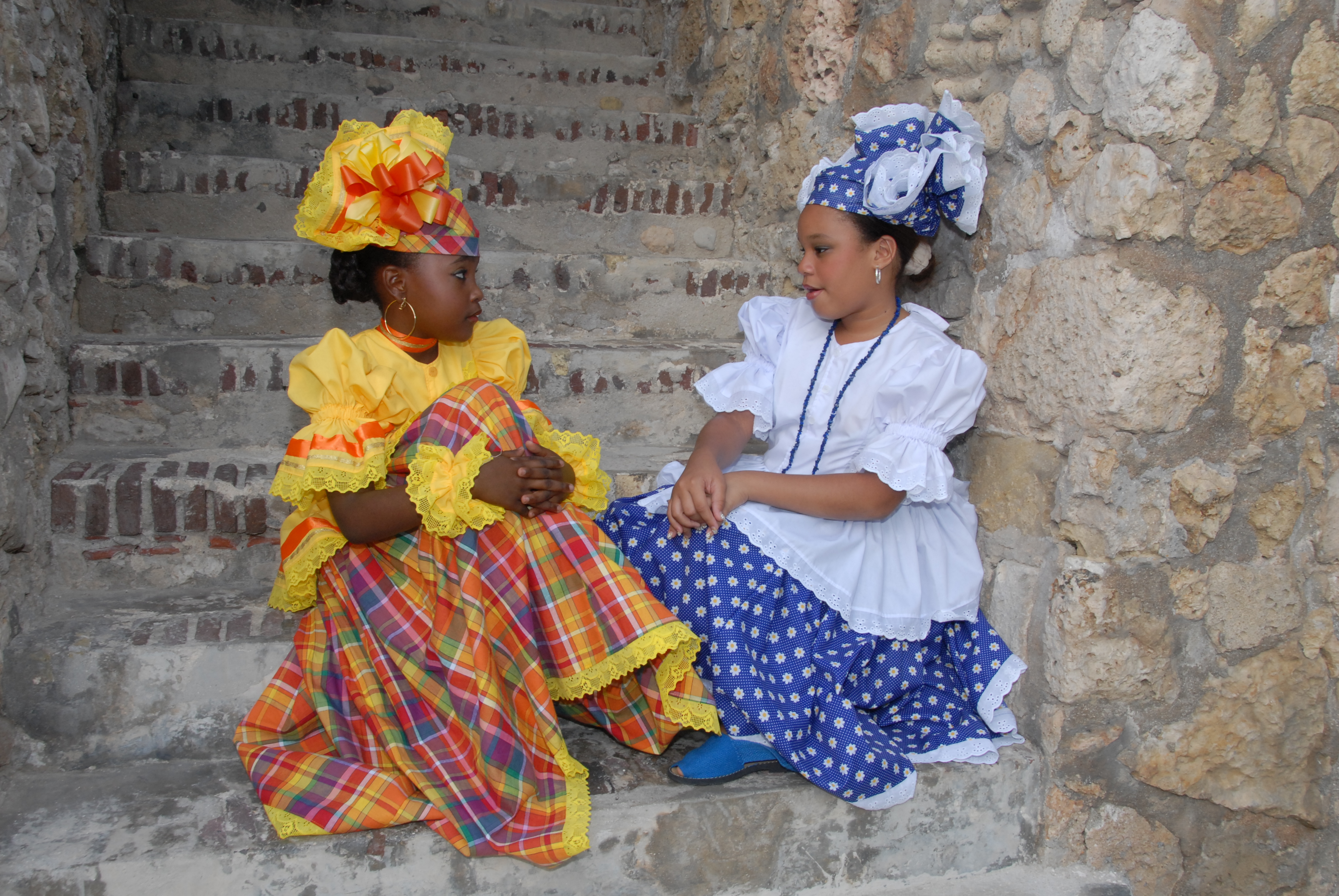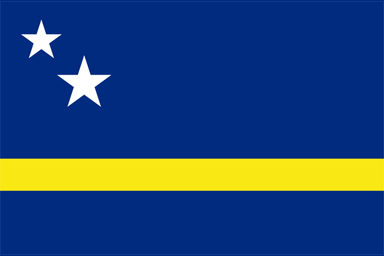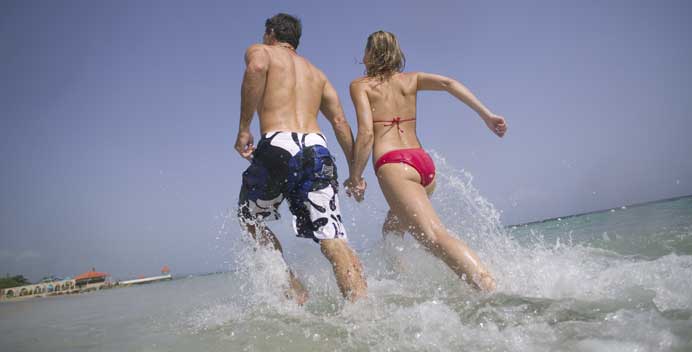The Caribbean Island of Curaçao
|
|
 Curacao is an island in the southern
Caribbean Sea, off the Venezuelan coast. The island area of Curaçao (Dutch: Eilandgebied
Curaçao, Papiamentu: Teritorio Insular di Kòrsou), which includes the main island plus the
small, uninhabited island of Klein Curaçao ("Little Curaçao"), is one of five island areas of
the Netherlands Antilles, and as such, is a part of the Kingdom of the Netherlands. Its
capital is Willemstad. Curacao is an island in the southern
Caribbean Sea, off the Venezuelan coast. The island area of Curaçao (Dutch: Eilandgebied
Curaçao, Papiamentu: Teritorio Insular di Kòrsou), which includes the main island plus the
small, uninhabited island of Klein Curaçao ("Little Curaçao"), is one of five island areas of
the Netherlands Antilles, and as such, is a part of the Kingdom of the Netherlands. Its
capital is Willemstad.
Curaçao is the largest and most populous of the three so called ABC islands (for Aruba, Bonaire,
and Curaçao) of the Lesser Antilles, specifically the Leeward Antilles. It has a land area of 444
square kilometers (171 square miles). As of 1 January 2008, it had a population of 140,796
History
The original inhabitants of Curaçao were Arawak
Amerindians. The first Europeans to see the island were members of a Spanish expedition under the
leadership of Alonso de Ojeda in 1499. The Spaniards exported most of the indigenous population to
other colonies where workers were needed. The island was occupied by the Dutch in 1634. The Dutch
West India Company founded the capital of Willemstad on the banks of an inlet called the
'Schottegat'. Curaçao had been previously ignored by colonists because it lacked many things that
colonists were interested in, such as gold deposits. However, the natural harbour of Willemstad
proved quickly to be an ideal spot for trade. Commerce and shipping — but also piracy — became
Curaçao's most important economic activities. In addition, the Dutch West India Company made
Curaçao a center for the Atlantic slave trade in 1662. Dutch merchants brought slaves from Africa
under a contract with Spain called Asiento. Under this agreement, large numbers of slaves were sold
and shipped to various destinations in South America and the Caribbean.
The slave trade made the island affluent, and led to the construction of impressive colonial
buildings. Curaçao features architecture that blends various Dutch and Spanish colonial styles. The
wide range of other historic buildings in and around Willemstad earned the capital a place on
UNESCO's world heritage list. Landhouses (former plantation estates) and West African style 'kas di
pal'i maishi' (former slave dwellings) are scattered all over the island and some of them have been
restored and can be visited.
|
Geography
|
|

Like Aruba and Bonaire, Curaçao is a transcontinental
island that is geographically part of South America but is also considered to be part of West
Indies and one of the Leeward Antilles. Curaçao and the other ABC Islands are in terms of
climate, geology, flora and fauna more akin to nearby Paraguaná Peninsula, Isla Margarita and
the nearby Venezuelan areas of the Coro region and Falcón State. The flora of Curaçao differs
from the typical tropical island vegetation. Xeric scrublands are common, with various forms
of cacti, thorny shrubs, evergreens, and the island's symbolic divi-divis. Curaçao's highest
point is the 375 metre (1,230 ft) Christoffelberg ("Mount Christoffel") in the northwestern
part of the island. This lies in the reserved wildlife park, Curaçao Christoffelpark, and can
be explored by car, bike or horse or on foot. Several trails have been laid out. Curaçao has
many places where one can hike. There are Saliñas, salt marshes where flamingos fly out to
rest and feed. 24km (15 miles) off the coast of Curaçao, to the southeast, lies the small,
uninhabited island of Klein Curaçao ("Little Curaçao").
Curaçao is renowned for its coral reefs which makes it an excellent spot for scuba diving. The
beaches on the south side contain many popular diving spots. An unusual feature of Curaçao diving
is that the sea floor drops off steeply within a few hundred feet of the shore, and the reef can
easily be reached without a boat. This drop-off is locally known as the "blue edge." Strong
currents and lack of beaches make the rocky northern coast dangerous for swimming and diving, but
experienced divers sometimes dive there from boats when conditions permit. The southern coast is
very different and offers remarkably calm waters. The coastline of Curaçao features many bays and
inlets, many of them suitable for mooring.
Some of the coral reefs have been affected by tourism. Porto Marie beach is experimenting with
artificial coral reefs in order to improve the reef's condition. Hundreds of artificial coral
blocks that have been placed are now home to a large array of tropical fish.
|
Climate
|
| Curaçao has a semi-arid savanna-like climate with a dry season from January to
September and a wet season from October to December. The temperatures are relatively constant with
small differences throughout the year. The trade winds brings cooling during the daylight and the
same trade winds brings warming during the night. The coldest month is January with an average
temperature of 79.7 °F (26.5 °C) and the warmest month is September with an average temperature of
84.0 °F (28.9 °C). The year's average daylight temperature is 88.2 °F (31.2 °C). The year's average
night temperature is 78.1 °F (25.3 °C). Curaçao lies outside the hurricane belt, but can still
occasionally be impacted by hurricanes. A landfall of a hurricane in Curaçao has not occurred since
National Hurricane Center started tracking of hurricanes. |
Culture
|
|

Curaçao Culture is a polyglot
society. The languages widely spoken are Papiamentu, Dutch, Spanish, and English. Many people can
speak all four of these languages. Spanish and English both have a long historical presence on the
island alongside Dutch and Papiamentu. Spanish remained an important language throughout the 18th
and 19th centuries as well due to the close economic ties with nearby Venezuela and Colombia. The
use of English dates back to the early 19th century, when Curaçao became a British colony. In fact,
after the restoration of Dutch rule in 1815, colonial officers already noted wide use of English
among the island (van Putte 1999).
Recent immigration from the Anglophone Caribbean and the Netherlands Antillean islands of (St.
Eustatius, Saba and Saint Maarten)—where the primary language is English—as well as the ascendancy
of English as a world language, has intensified the use of English on Curaçao. For much of colonial
history, Dutch was never as widely spoken as English or Spanish and remained exclusively a language
for administration and legal matters; popular use of Dutch increased towards the end of the 19th
century and the early 20th century (van Putte 1999).
Historically, education on Curaçao, Aruba and Bonaire had been predominantly in Spanish up until
the late 19th century. There were also efforts to introduce bilingual popular education in Dutch
and Papiamentu in the late 19th century (van Putte 1999). Dutch was made the sole language of
instruction in the educational system in the early 20th century to facilitate education for the
offspring of expatriate employees of Royal Dutch Shell (Romer, 1999). Papiamentu was tentatively
re-introduced in the school curriculum during the mid-1980s. Recent political debate has centered
on the issue of Papiamentu becoming the sole language of instruction.
Proponents of making Papiamentu the sole language of instruction argue that it will help to
preserve the language and will improve the quality of primary and secondary school education.
Proponents of Dutch-language instruction argue that students who study in Dutch will be better
prepared for the free university education offered to Curaçao residents in the Netherlands.
Effective July 1, 2007, the Netherlands Antilles declared Dutch, Papiamentu, and English as
official languages, in recognition of the Dutch-speaking, Papiamentu-speaking and English-speaking
communities of all the islands.
|
The flag of Curaçao
|
|

Curaçao Flag is a blue field with a horizontal yellow stripe slightly below the midline and two
white, five-pointed stars in the canton. The blue symbolises the sea and sky (the bottom and top
blue sections, respectively) divided by a yellow stroke representing the bright sun which bathes
the island. The two stars represent Curaçao and Klein Curaçao, but also 'Love & Happiness'. The
five points on each star symbolise the five continents from which Curaçao's people come.
According to Flags of the World, the horizontal stripe have ratio 5:1:2. The stars have
diameters 1/6 and 2/9 of the flag height. The centre of the smaller one is 1/6 the flag height from
the left and top edges, and the centre of the larger is 1/3 from the left and top edges. The blue
is Pantone 280, and the yellow, Pantone 102.
After the adoption of the flag by Aruba, Curaçao received approval for a flag in 1979. 2,000
thousand designs were submitted to a special council. 10 were shortlisted and the council decided
on 29 November 1982. With some modifications, the flag adopted on 2 July 1984.
|
Discover Curacao
|
|

Bike Rentals and
Tours
Discover Curacao and get some exercise at the same time! Cycle
through the beautiful natural surroundings and the real Curacao countryside. The cycling tour
ends at one of the many beaches on Curacao.
Bowling
A great vacation is going away to an
exotic place and having all the comforts of home. And when you go out at night, you want to be sure
that you get your money's worth of fun. You want to spend an evening on the bowling alley? Be sure
to check out the Curaçao Bowling Club.
|
|
Canoe Safari
Why not paddle
right along the impressive south coast of Banda Abou in stable and sea-worthy canoes? You will have
plenty of time to enjoy the underwater world and the beauty of Curaçao's shoreline. We will take in
the best snorkelling spots and visit five unspoiled beaches, stopping for a cool drink, some fruit
and a refreshing swim.
Fishing
The 'Eembaai' and 'Schottegat' both have a rich stocks of tarbot and pike throughout the entire
year. April, May and June are the top months with to reel in some really large. In some bays it is
possible to fish for barracuda, horse-eye jack and ladyfish in addition to tarbot and pike.
Horsebackriding
Manege SHC offers riding tours, from half a hours in their own 'Kabouterbos' on the opposite of the
riding school till a 5 hours ride to the Zoutpannen at Jan Thiel or to the north coast of the
island.
Jeep Safari
Get to know the beautiful
and rugged Curaçao countryside by jeep. Jeep safaris take you along narrow tracks past grand
estates, mansions, caves, flamingos and huge fields of cactus and many gorgeous beaches. For
experienced drivers, night rallies are organised. Great fun!
Windsurfing (Classes & Rentals)
Imagine yourself speeding over the water. You can do it! Windsurfing Curacao's specialized beginner
equipment will get you going in less the one hour!
Windsurf in Curacao using their well maintained
rental boards. From beginner to expert they have a board and a sail to match your
ability.
|
Getting married in Curaçao
|
|
Information listed below is Requirements for Marriage in Curacao
* You and your future life partner must be living outside the Netherlands Antilles.
* At least two months before your wedding day you must notify in writing from abroad that you wish
to be married. Together with your request you add the corresponding original documents.
a) Birth Certificate (not older than 6 months)
b) Valid passport
c) Evidence that you are single (not older than 6 months)
d) If your were divorced or if you are a widow/widower, please present evidence of this (not older
than 6 months).
e) You may be asked for more documents, this depends on your personal circumstances. You will be
notified on this item as per item #3.
* Within two weeks after the Register Office has received and checked your documents, you will be
notified if everything is in order & when and what time your marriage will be performed. If
there are any documents lacking, or not in order, or if more documents are necessary, you will be
informed at this time.
* The legal ten-day period between the notification of your wedding and the performing of it, is
effective two weeks after all the documents have arrived at the Register Office. All documents must
by that time have been approved by the Register Office.
* In order to identify the bridal couple it is important that you report to the Register
Office 3 days at the latest before your get married; you can then also make the acquaintance of the
official of the Register Office.
* This complicated rule is in your own interest to safeguard your marriage and to allow for any
contingency. Your have to hand in the original documents together with your notice of marriage, or
you must have these documents with you when you are on the island.
1. The following countries are exempt from authentication: Aruba,
Italy, Austria, Belgium, Luxembourg, Portugal, Germany, Turkey, France, Switzerland, The
Netherlands, Netherlands Antilles
Treaty of Luxembourg, September 26, 1957, treaty publication 1968, 168 Exception from
authentication
1. The wedding package costs between NAFL 350 and NAFL 750
2. The marriage certificate is charged separately and costs NAFL 32.50
Registrars Offices
The registrar's office should be contacted for specific rules regarding planning your destination
or beach wedding in Curacao. They will also provide information regarding marriage licenses and
marriage certificates.
The Register Office of Curacao
Burgerlijke Stand Bevolkingsregister en Verkiezingen (BSB&V)
A.M. Churnanceiro Boulevard 13, Willemstad
Curacao
Tel: 5999 461 1844 Fax: 5999 461 8166
Email: info.bsbv@curacao-gov.an
|
|